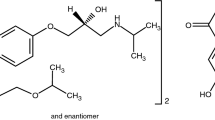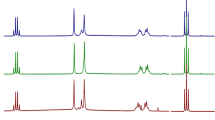Abstract
Four polymorphic forms (I, II, III and IV) of hydrochlorothiazide have been characterized on the basis of x-ray diffractometry and differential thermal analysis. Form I was obtained by crystallization from N,N-dimethylformamide and Form II was crystallized from hot methanol. Form III was precipitated from sodium hydroxide aqueous solution by treatment with hydrochloric acid and Form IV was crystallized from 50% methanol. The metastable form I was a most stable form among four polymorphs, which was stable more than ten months at room temperature. The thermodynamic parameters such as heat of solution, enthalpy, entropy, free energy difference and transition temperature were determined by the measurement of intrinsic dissolution rate. The transition temperature and the heat of transition between the metastable Form I and Form II were determined to be 299.15°K and 5.03 Kcal/mole, respectively and free energy difference (δF) was 302.13 cal/mole. Diuretic action of these four polymorphic forms was also evaluated by monitoring the difference in urinary excretion of sodium, potassium and magnesium in rats.
Similar content being viewed by others
Literature Cited
Martin, A., Swarbrick, J. and Cammarata, A.:Physical Pharmacy, 3rd Ed., Lea & Febiger, 72 (1983).
Aguiar, A.J., Kinkel, A.W. and Samyn, J.C.: Effect of polymorphism on the absorption of chloramphenicol from chloramphenicol palmitate.J. Pharm. Sci. 56, 847(1967).
Aguiar, A.J. and Zelmer, J.E.: Dissolution behavior of polymorphs of chloramphenicol palmitate and mefenamic acid.J. Pharm. Sci. 58, 983 (1969).
Mullins, J.D. and Macek, T.J.: Some pharmaceutical properties of novobiocin.J. Amer. Pharm. Assoc. 49, 245(1960).
Simmons, D.L., Ranz, R.J. and Gyanchandani, N.D., Polymorphism in pharmaceuticals III: Chloropropamide.Can. J. Pharm. Sci. 8, 125 (1973).
Had, A., Mezösi, J., Kedvessy, G. and Morvay, J.: Biopharmaceutical studies on sulphadimidine modifications.Pharmazie 32, 791(1977).
Kato, Y. and Watanabe, F.: Relationship between polymorphism and kioavailobility of phenobarbital.Yakugaku Zasshi 98, 639(1978).
Martin, A., Swarbrick, J. and Cammarata, A.:Physical Pharmacy, 3rd Ed., Lea & Febiger, 575, (1983).
Poole, J.W. and Bahal, C.K.: Dissolution behavior and solubility of anhydrous and trihydrate forms of ampicillin.J. Pharm. Sci. 57, 1945(1968).
Clements, J.A. and Popli, S.D.: The preparation and properties of crystal modification of meprobamate.Can. J. Pharm. Sci. 8, 89(1973).
Jamali, F. and Mitchell, A.G., The recrystallization and dissolution of acetylsalicylic acid.Acta Pharm. Suecica. 10, 343(1973).
Florence, A.T. and Salolc, E.G.: Changes in crystallinity and solubility on comminution of digoxin and observations on spironolactone and oestradiol.J. Pharm. Pharmac. 28, 637(1975).
Ghielmetti, G., Bruzzess, T., Bianchi, C. and Recusani, F.: Relationship between acute toxicity in mice and polymorphic forms of polyene antibiotics.J. Pharm. Sci. 65, 905(1976).
Thakkar, A.L., Hirsch, C.A. and Page, J.G.: Solid dispersion approach for overcoming bioavailability problems due to polymorphism of nabilone, a cannabinoid derivative.J. Pharm. Pharmac. 29, 783(1977).
Lachman, L., Lieberman, H.A. and Kanig, J.L.:The Theory and Proctice of Industrial Pharmacy. Lea & Febiger, Philadelphia (1976).
Leary, W.P., Asmal, A.C. and Reyes, A.J.: Time-course of the diuretic, natriuretic and kaliuretic effects of xipamide.Curr. Ther. Res. 27, 16(1980).
McLeod, P.L., Ogilvie, R.I. and Ruedy, J.: Effects of large and small doses of hydrochlorothiazide in hypertensive patients.Clin. Pharm. Thera. 11, 733(1970).
Sutton, R.A.L. and Walker, V.R.: Responses to hydrochlorothiazide and acetazolamide in patients with calcium stones.New Engl. J. Med. 302, 709(1980).
Carstensen, J.T.:Theory of Pharmaceutical Systems, Vol. II, Academic Press (1973).
Wadke, D.A. and Reier, G.E.: Use of intrinsic dissolution rates to determine thermodynamic parameters associated with transition.J. Pharm. Sci. 61: 868(1972).
Author information
Authors and Affiliations
Rights and permissions
About this article
Cite this article
Kim, B.H., Kim, J.K. Pharmaceutical studies on the polymorphism of hydrochlorothiazide. Arch. Pharm. Res. 7, 47–52 (1984). https://doi.org/10.1007/BF02856921
Received:
Issue Date:
DOI: https://doi.org/10.1007/BF02856921




